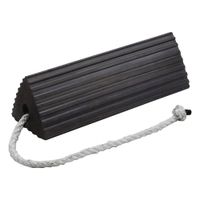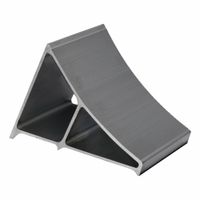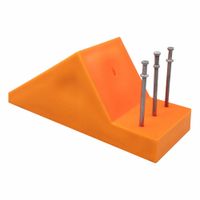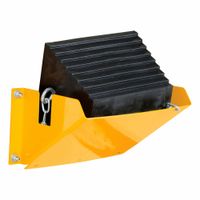Call +(254) 703 030 000 / 751 483 999 / 721 704 777
- Home
- Material Handling
- Dock Loading Equipment
- Wheel Chocks
.....Read More
Frequently Asked Questions
What are wheel chocks used for?
Wheel chocks are devices used to prevent the accidental movement of vehicles or equipment. They are typically wedge-shaped and placed snugly against the wheels to immobilize them. Wheel chocks are essential for safety in various settings, including aviation, automotive, and industrial environments.
In aviation, wheel chocks are used to secure aircraft when parked, especially on sloped surfaces or during windy conditions. They prevent the aircraft from rolling away, ensuring safety during loading, unloading, and maintenance operations.
In the automotive industry, wheel chocks are used when vehicles are parked on inclines or during maintenance activities like tire changes. They provide stability and prevent the vehicle from rolling, reducing the risk of accidents.
In industrial settings, wheel chocks are used for heavy machinery and equipment. They ensure that equipment remains stationary during operation or maintenance, enhancing workplace safety.
Wheel chocks are made from various materials, including rubber, plastic, and metal, each suited for different applications and weight capacities. They often feature a textured surface to increase friction and prevent slipping.
Proper use of wheel chocks involves placing them on both sides of the wheel, ensuring they are in contact with the tire and the ground. It's crucial to select the appropriate size and type of chock based on the vehicle's weight and the surface conditions.
Overall, wheel chocks are a simple yet vital safety tool that helps prevent accidents and ensures the stability of vehicles and equipment in various environments.
How do you properly use wheel chocks?
To properly use wheel chocks, follow these steps:
1. **Select the Right Chocks**: Choose chocks that are appropriate for the vehicle's size and weight. They should be made of durable materials like rubber, polyurethane, or metal.
2. **Inspect the Chocks**: Before use, check for any damage or wear that could compromise their effectiveness.
3. **Position the Vehicle**: Park the vehicle on a flat, stable surface. If on an incline, ensure the vehicle is facing uphill.
4. **Engage the Parking Brake**: Always set the parking brake to provide additional security.
5. **Determine Chock Placement**: For a vehicle on a flat surface, place chocks on both sides of at least one wheel. On an incline, chock the wheels on the downhill side.
6. **Place the Chocks**: Position the chocks snugly against the tire tread. For dual-axle vehicles, chock both axles. Ensure the chocks are centered and make full contact with the tire.
7. **Test Stability**: Gently rock the vehicle to ensure it is stable and the chocks are secure.
8. **Use Additional Chocks if Necessary**: For larger vehicles or steeper inclines, use additional chocks for added security.
9. **Remove Chocks Safely**: When ready to move the vehicle, ensure the parking brake is engaged, then remove the chocks. Store them properly for future use.
10. **Regular Maintenance**: Periodically inspect and clean the chocks to maintain their effectiveness.
By following these steps, wheel chocks can effectively prevent accidental vehicle movement, ensuring safety during maintenance or parking.
What size wheel chocks do I need?
To determine the appropriate size of wheel chocks you need, consider the following factors:
1. **Vehicle Type and Weight**: The size and weight of your vehicle are crucial. Larger and heavier vehicles, such as trucks or RVs, require larger and more robust chocks. Check the vehicle's gross weight and ensure the chocks are rated to handle it.
2. **Tire Diameter**: The chock should be approximately 1/4 of the tire's diameter. Measure the tire diameter and select a chock that matches this proportion to ensure it fits snugly against the tire.
3. **Slope or Incline**: If parking on an incline, larger chocks may be necessary to prevent movement. The steeper the slope, the larger and more secure the chock should be.
4. **Material**: Wheel chocks come in various materials, including rubber, plastic, and metal. Rubber chocks are durable and provide good grip, while plastic chocks are lightweight and suitable for smaller vehicles. Metal chocks are typically used for heavy-duty applications.
5. **Environmental Conditions**: Consider the environment where the chocks will be used. For example, rubber chocks are ideal for wet or icy conditions due to their grip, while metal chocks may be better for extreme temperatures.
6. **Regulations and Standards**: Check any industry standards or regulations that may apply, especially for commercial vehicles. Compliance with these standards ensures safety and legality.
7. **Additional Features**: Some chocks come with added features like handles for easy placement, reflective strips for visibility, or interlocking capabilities for added stability.
By considering these factors, you can select the appropriate size and type of wheel chocks to ensure safety and stability for your specific vehicle and conditions.
Are wheel chocks necessary for all vehicles?
Wheel chocks are not necessary for all vehicles in every situation, but they are crucial in specific circumstances to ensure safety. Wheel chocks are devices placed against a vehicle's wheels to prevent accidental movement, especially on inclined surfaces. They are essential for vehicles parked on slopes, during maintenance, or when the parking brake is unreliable.
For heavy vehicles like trucks, trailers, and RVs, wheel chocks are often mandatory due to their significant weight and potential for movement. Regulations in some industries require their use to prevent accidents during loading and unloading. In aviation, wheel chocks are critical for aircraft safety on the ground.
For everyday passenger vehicles, wheel chocks are generally not necessary on flat surfaces if the parking brake is functional. However, they provide an extra layer of security when working under the vehicle or when parked on a slope. In these cases, using wheel chocks can prevent the vehicle from rolling, reducing the risk of accidents.
In summary, while wheel chocks are not universally required for all vehicles, they are a vital safety tool in specific situations, particularly for heavy vehicles, on inclines, or during maintenance. Their use is determined by the vehicle type, parking conditions, and safety regulations.
What materials are wheel chocks made from?
Wheel chocks are typically made from a variety of materials, each chosen for its specific properties that enhance the chock's effectiveness in preventing vehicle movement. Common materials include:
1. **Rubber**: Rubber wheel chocks are popular due to their durability, resistance to weather conditions, and excellent grip on various surfaces. They are often used in industrial and commercial settings because they can withstand heavy loads and provide a non-slip surface.
2. **Polyurethane**: This material is known for its lightweight and high strength. Polyurethane chocks are resistant to oils, fuels, and other chemicals, making them suitable for environments where such substances are present. They are also less likely to crack or degrade over time compared to rubber.
3. **Plastic**: High-density polyethylene (HDPE) or other robust plastics are used to make lightweight and cost-effective wheel chocks. These are often used for lighter vehicles and in situations where portability is a priority.
4. **Aluminum**: Aluminum wheel chocks are lightweight yet strong, making them ideal for aircraft and other applications where weight is a concern. They are resistant to corrosion and can handle significant pressure.
5. **Steel**: Steel chocks are extremely durable and are used in heavy-duty applications, such as securing large trucks or heavy machinery. They are often coated to prevent rust and corrosion.
6. **Wood**: Traditionally, wood was a common material for wheel chocks. While less common today, wooden chocks are still used in some applications due to their availability and ease of customization.
Each material offers distinct advantages, and the choice often depends on the specific requirements of the application, such as the type of vehicle, environmental conditions, and safety standards.
How many wheel chocks should be used per vehicle?
Two wheel chocks should be used per vehicle.
Can wheel chocks be used on all surfaces?
Wheel chocks are designed to prevent vehicles from unintentionally moving, and their effectiveness can vary depending on the surface they are used on. While wheel chocks can be used on many surfaces, their performance is influenced by the material and condition of the surface.
On hard, flat surfaces like concrete or asphalt, wheel chocks generally perform well. These surfaces provide a stable base, allowing the chocks to grip effectively and prevent vehicle movement. Rubber or urethane chocks are particularly effective on these surfaces due to their high friction and durability.
On softer surfaces such as gravel, dirt, or grass, wheel chocks may not be as effective. The chocks can sink into the surface, reducing their ability to hold the vehicle in place. In such cases, larger chocks with a wider base or those specifically designed for off-road use may be more suitable. Some chocks come with features like teeth or spikes to improve grip on loose surfaces.
On icy or wet surfaces, the risk of slippage increases. Chocks with anti-slip features or those made from materials that maintain grip in wet conditions are preferable. However, caution is still advised, as extreme conditions can compromise the effectiveness of any chock.
In summary, while wheel chocks can be used on various surfaces, their effectiveness is contingent upon the surface type and condition. Selecting the appropriate chock material and design for the specific surface is crucial to ensure safety and prevent vehicle movement.






